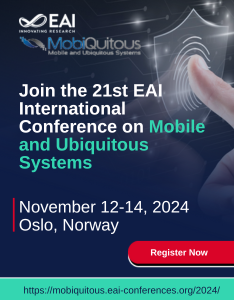
Research Article
Learnings from an Iterative Design Process for Technology-Mediated Audience Participation (TMAP) using Smartphones
@ARTICLE{10.4108/eai.16-1-2018.153643, author={Fares Kayali and Oliver Hodl and Christoph Bartmann and Ulrich Kuhn and Thomas Wagensommerer and Ruth Mateus-Berr}, title={Learnings from an Iterative Design Process for Technology-Mediated Audience Participation (TMAP) using Smartphones}, journal={EAI Endorsed Transactions on Creative Technologies}, volume={5}, number={14}, publisher={EAI}, journal_a={CT}, year={2018}, month={1}, keywords={technology-mediated audience participation; TMAP; live music; smartphones; high-frequency sound IDs; iterative design.}, doi={10.4108/eai.16-1-2018.153643} }- Fares Kayali
Oliver Hodl
Christoph Bartmann
Ulrich Kuhn
Thomas Wagensommerer
Ruth Mateus-Berr
Year: 2018
Learnings from an Iterative Design Process for Technology-Mediated Audience Participation (TMAP) using Smartphones
CT
EAI
DOI: 10.4108/eai.16-1-2018.153643
Abstract
We discuss a setup for technology-mediated audience participation (TMAP)in live music using smartphones and high-frequency sound IDs in a playful setting. The audience needs to install a smartphone app. Using high-frequency sound IDs music samples and colors can be triggered on the audience’s smartphones without the need to have an internet connection. The resulting soundscape is determined by the samples and parameters selected by the artist as well as by the location audience members choose in the performance space. We present the technical basis and iterative explorative design process of such a system for TMAP. The learnings from the perspective of musicians were technical requirements such as low latency, reliability, as well as increasing the number of possible sound samples and sound quality and we further present learnings on creating systems for TMAP from technical and creative perspectives.
Copyright © 2018 Kayali et al., licensed to EAI. This is an open access article distributed under the terms of the Creative Commons Attribution licence (http://creativecommons.org/licenses/by/3.0/), which permits unlimited use, distribution and reproduction in any medium so long as the original work is properly cited.


